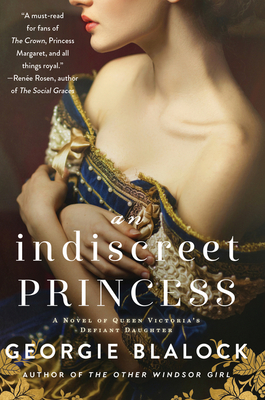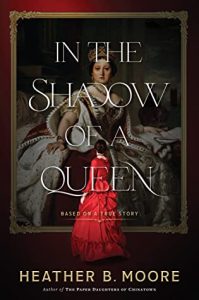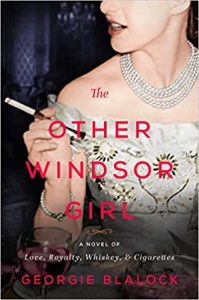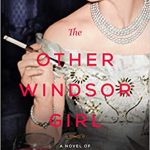 An Indiscreet Princess: A Novel of Queen Victoria's Defiant Daughter by Georgie Blalock
An Indiscreet Princess: A Novel of Queen Victoria's Defiant Daughter by Georgie Blalock Format: eARC
Source: supplied by publisher via Edelweiss
Formats available: paperback, ebook, audiobook
Genres: biography, historical fiction
Pages: 400
Published by William Morrow & Company on September 27, 2022
Purchasing Info: Author's Website, Publisher's Website, Amazon, Barnes & Noble, Kobo, Bookshop.org, Better World Books
Goodreads
From the acclaimed author of The Other Windsor Girl and The Last Debutantes comes a brilliant novel about Queen Victoria’s most rebellious and artistically talented daughter, Princess Louise, showcasing her rich life in Georgie Blalock’s signature flair.
Before Princes Margaret, before Duchess Meghan, there was Princess Louise: royal rebel.
As the fourth daughter of the perpetually in-mourning Queen Victoria, Princess Louise’s life is more a gilded prison than a fairy tale. Expected to sit quietly next to her mother with downcast eyes, Louise vows to escape the stultifying royal court. Blessed with beauty, artistic talent, and a common touch, she creates a life outside the walled-in existence of the palace grounds by attending the National Art Training School—where she shockingly learns to sculpt nude models while falling passionately in love with famed sculptor Joseph Edgar Boehm.
Although Louise cultivates artist friends, artistic success, and a life outside the palace, she quickly learns that even royal rebels must heed the call of duty. For twenty years, Louise fights to maintain her relationship with Joseph and what freedom she can glean within the strict requirements of Queen Victoria’s court. When a near fatal accident forces her back under Queen Victoria’s iron rule, Louise must choose between surrendering to the all-consuming grief of lost love and dreams that plagued her mother or finding the strength to keep fighting for her unconventional life.
My Review:

An Indiscreet Princess is the second book this season to present a fictionalized biography of Queen Victoria’s artistic, iconoclastic daughter Louise. Considering the life that she led, it’s not surprising that Louise has become the focus of more than one such book Instead it’s a wonder why her story hasn’t been told before.
Louise’s mother may have reigned over the sexually repressive regime that bears her name, but even the contemporary rumors about Louise’s behavior give the impression that Louise was anything but repressed – no matter how much her royal mother may have tried to make her toe the line of the straight and narrow.
But Louise, who managed to become known in her own right and in her own time as a talented and even successful sculptor, still had to fight that repression from, at the very least, the day her father Prince Albert died until Victoria herself either mellowed or died – whichever came first.
By all accounts, even though Queen Victoria’s power over her empire had been waning throughout her reign – in part due to her own actions or inactions – her rule over her family was nearly absolute. Especially over the lives of her daughters, who she expected to serve as her personal secretaries until she deigned to decide upon and preside over their marriages. And whose world she still expected to be the very center of for the rest of her – or their – lives.
But the center of Louise’s life was her art. No matter how much her imperial – and imperious – mother tried to restrict every aspect of her life – including how much training she would receive and how much – or how little – space she would be given to practice it. So she rebelled where she could and toed the line when she absolutely had to.
And managed to succeed – if not on her own terms at least on terms that both she and her mother could live with. At least some of the time.
 Escape Rating B: Both In the Shadow of a Queen and An Indiscreet Princess fictionalize the life of the very same person. Meaning that the outlines of both stories are pretty much the same. But the way that those outlines are filled in is quite a bit different.
Escape Rating B: Both In the Shadow of a Queen and An Indiscreet Princess fictionalize the life of the very same person. Meaning that the outlines of both stories are pretty much the same. But the way that those outlines are filled in is quite a bit different.
It’s as if the two Princesses Louise are twins who are living out the all-too-common scenario of a “good” twin and a “bad” twin. A scenario that occurs in many families, where one child is rewarded for being dutiful and obedient while the other gets attention the only way that remains to them – by acting out at every turn.
In the Shadow of a Queen told the story of the “good” twin. That Louise pursued her art relentlessly – and did clash with her mother because of it. But she was portrayed as a dutiful if reluctant personal secretary, and more distinctly in comparison with this book, her marriage to Lord Lorne was described as a love match between two people who liked and respected each other and expected to be as happy as their circumstances would allow. That version of Louise’s story also dismissed all of the rumors about her many reputed affairs and never even touched on the rumors that Lord Lorne was homosexual. That book ended just as they married, leaving open the possibility of a happy ever after that did not happen in real life.
An Indiscreet Princess, very much on the other hand, leans into all the salacious gossip and leans into so hard it falls over into more than a few pre- and post-marital beds. (It also explicitly reinforces the worst of the rumors about Queen Victoria’s behavior with her Scottish manservant John Brown) It is, admittedly, a much more fun account of Louise’s life than the other, a feeling that is helped by starting her story later, as she is inveigling her mother to let her attend art school, and a point where Louise has a bit more agency – or at least more awareness of just how little she has – than in Shadow which begins with Prince Albert’s death and glums its way through the worst of Victoria’s mourning years.
While the Princess in Indiscreet is more interesting to read about, because she thinks more and does more, this is also a story about a lot of privileged people being privileged and selfish and generally behaving fairly badly to each other while not considering ANY of the effects on anybody else. What seem like more frank portraits of everyone in the royal orbits is more interesting to read – as tell-all gossips often are – but doesn’t leave the reader with a whole lot of sympathy for much of anyone involved.
 All of which is a very different reaction than I had to the author’s previous book about one of the royal family’s other notorious scapegraces, The Other Windsor Girl about the life of Princess Margaret. Which I liked quite a bit better because while the focus in that book was on Margaret, the story is told from an outsider’s perspective which lets us see, perhaps, a bit more clearly than Louise is able to see herself.
All of which is a very different reaction than I had to the author’s previous book about one of the royal family’s other notorious scapegraces, The Other Windsor Girl about the life of Princess Margaret. Which I liked quite a bit better because while the focus in that book was on Margaret, the story is told from an outsider’s perspective which lets us see, perhaps, a bit more clearly than Louise is able to see herself.

















